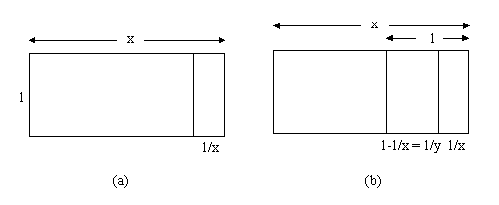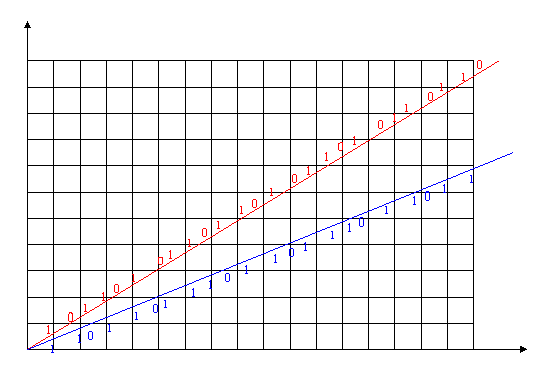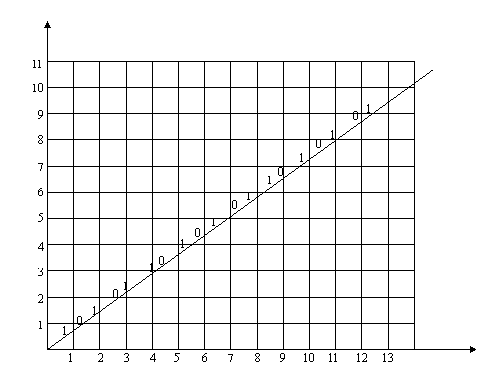|
Consider a rectangle of proportions 1: x
subdivided according to the law of repetition
of ratios into a unit of the same ratio and a
gnomon (see Figure 6a). In Figure 6b a square
placed into this rectangle produces a pair of proportions
1/x and 1-1/x = (x-1)/x = 1/y
where 1/x + 1/y = 1. If x and y are
irrational numbers then we can apply Beatty's Theorem.

Theorem (Beatty's): If x and y are irrational numbers such that 1/x + 1/y = 1 (Beatty pairs), then the set {[nx], [ny]} for n = 1,2,3,..., where [ ] denotes "the integer part of", equals the set of natural numbers with no repeats. The following Beatty pairs correspond to the golden mean, root 2, and root 3 systems of proportion, respectively: 1) x = f, y = f2; 2) x = Ö2, y = qÖ 2; and 3) x = Ö3, y = a Ö3. Table 1 illustrates Beatty's Theorem for the Ö3 system.
n [nÖ3] [naÖ3]
1 1 2
If the numbers in column 2 are assigned a 1 while the numbers in column 3 are assigned a 0, the numbers in Table 1 are listed in order as 1 0 1 0 1 1 0 1 0 1 0 1 1 0 1 0 1 0 1 ... (12a) This sequence is known in the theory of dynamical systems as the symbolic dynamics. Notice that it contains all the information concerning the approximating sequence to Ö 3 given by sequence 8a. For example 1/2 of the first two numbers in sequence 12a are 1's, 3/5 of the first five numbers are 1's, 11/19 of the first 19 numbers are 1's, etc. In a similar manner the symbolic dynamics for the f system and the Ö 2 system are:
f:
1 0 1 1 0 1 0 1 1 0 1 1 0 1 0 1 1 ...
(12b)
These also replicate their approximating sequence 3 and 5.
The symbolic dynamics can also be generated by drawing
a line with slope x/y on a coordinate system
with vertical and horizontal lines drawn at integer
values of the coordinates. Where this line cuts a vertical
coordinate line assign a 1; where it crosses
a horizontal coordinate line assign a 0. The symbolic
dynamics for the f,
Ö2, and Ö3
systems is illustrated in this manner in Figure 7.
The ratio, 1/x, can be thought of as the probability
of getting a 0 in the above sequence while 1/y is the
probability of getting a 1, in which case the slope of
the line represents the odds of getting a 0.


|